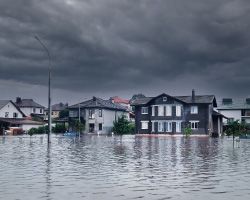Health library
Back to health libraryMake a flood plan

Floods can happen fast—and they can be deadly. Knowing what to do before, during and after a flood can help you stay safe. Get started with this advice from the American Red Cross, Centers for Disease Control and Prevention (CDC) and Ready.gov.
Before a flood
- Know if your home is vulnerable to flooding or if it's high enough to stay out of rising waters.
- If you have a generator, know how to use it as directed.
- Identify your nearest evacuation shelter.
- Know what to pack if you have to leave your home. Bring any medications you need, copies of important records, and power cords and backup batteries for phones or other electronics.
- Stock up on water. Buy or fill sanitized bottles with drinking water. A good amount is 1 gallon per person, per day. Unfortunately, it's not safe to store drinking water in bathtubs or sinks, which can leak lead into the water. Instead, use that water for washing up and flushing toilets.
- Have enough nonperishable food for three days or more. Refrigerated foods won't keep long if the electricity goes out. They aren't safe to eat if they've been at temperatures higher than 40 degrees for more than two hours. Toss them out to be safe.
- Buy sandbags and tarps. Your purchase may be covered afterward by your National Flood Insurance Program policy when flooding is predicted.
- Stay up-to-date on the latest news. A battery- or crank-powered radio can be a helpful backup if the power goes out.
During a flood
Seek safety first. Evacuate the area if you're told to. If you can't, move to higher ground or a higher floor in a safe building. If you can't find a safer place, stay where you are.
Never drive through floodwaters. A fast-moving stream of water, even if it doesn't look deep, can stall your car or even carry it away. Also, stay off bridges over fast-moving water. It's possible for debris to damage supporting structures and cause collapse.
Don't walk or swim in floodwaters. Fast-moving water carrying debris can knock you down and drown you. And CDC warns that contaminants can cause injuries and serious illness. The dangers, even in standing water, include:
- Downed electrical lines.
- Bacteria from human and animal waste that can cause diarrhea.
- Chemical, biological and radioactive waste.
- Glass or metal fragments that can cut skin and cause infections.
- Large objects like lumber, vehicles, trees, branches and other debris.
- Wild or stray animals such as rodents or snakes.
If you're accidentally exposed to floodwaters, here's how to protect yourself:
- Wash with clean water and soap as soon as you can. If you can't, use sanitizing gel or alcohol-based wipes.
- Clean out wounds and get medical help if needed.
- If you have to go into floodwater, wear protective gear: rubber boots, rubber gloves and goggles.
- Wash floodwater-soaked clothing in hot water and detergent.
What to do if your home has been flooded
- Return during the day.
- Use only battery-powered flashlights and lanterns.
- Turn off the main power to avoid electrocution. Turn off the main gas valve if you smell gas or suspect a leak.
- Have an electrician check the system before turning power back on.
- Open doors and windows to let fresh air in and help dry the inside.
- Follow local guidance on whether well water or public water supplies are safe.
- Throw out any food that's been in contact with floodwaters.
Want to know more about preparing for a flood? Check out our Disaster preparedness health topic center.
Reviewed 7/15/2025
Sources
- American Red Cross. "Flood Safety." https://www.redcross.org/get-help/how-to-prepare-for-emergencies/types-of-emergencies/flood.html.
- American Red Cross. "Flood Safety Checklist." https://www.redcross.org/content/dam/redcross/atg/PDF_s/Preparedness___Disaster_Recovery/Disaster_Preparedness/Flood/Flood.pdf.
- Centers for Disease Control and Prevention. "Floods and Your Safety." https://www.cdc.gov/floods/about/index.html.
- Centers for Disease Control and Prevention. "Safety Guidelines: Floodwater." https://www.cdc.gov/floods/safety/floodwater-after-a-disaster-or-emergency-safety.html.
- Centers for Disease Control and Prevention. "Safety Guidelines: Reentering Your Flooded Home." https://www.cdc.gov/floods/safety/reentering-your-flooded-home-safety.html.
- FloodSmart.gov. "What To Do Before a Flood." https://www.floodsmart.gov/first-prepare-flooding.
- Ready.gov. "Floods." https://www.ready.gov/floods.
- Ready.gov. "Be Prepared for a Flood." https://www.ready.gov/sites/default/files/2024-03/ready.gov_flood_hazard-info-sheet.pdf.
- U.S. Environmental Protection Agency. "Climate Change Indicators: Weather and Climate." https://www.epa.gov/climate-indicators/weather-climate.
- U.S. Food and Drug Administration. "Are You Storing Food Safely?" https://www.fda.gov/consumers/consumer-updates/are-you-storing-food-safely.
